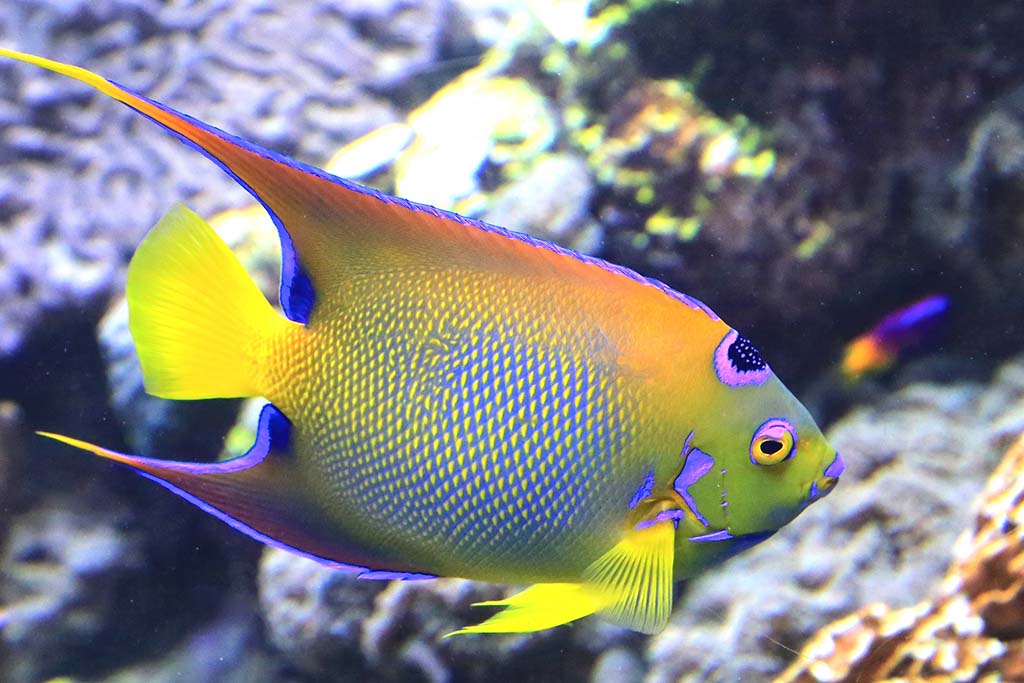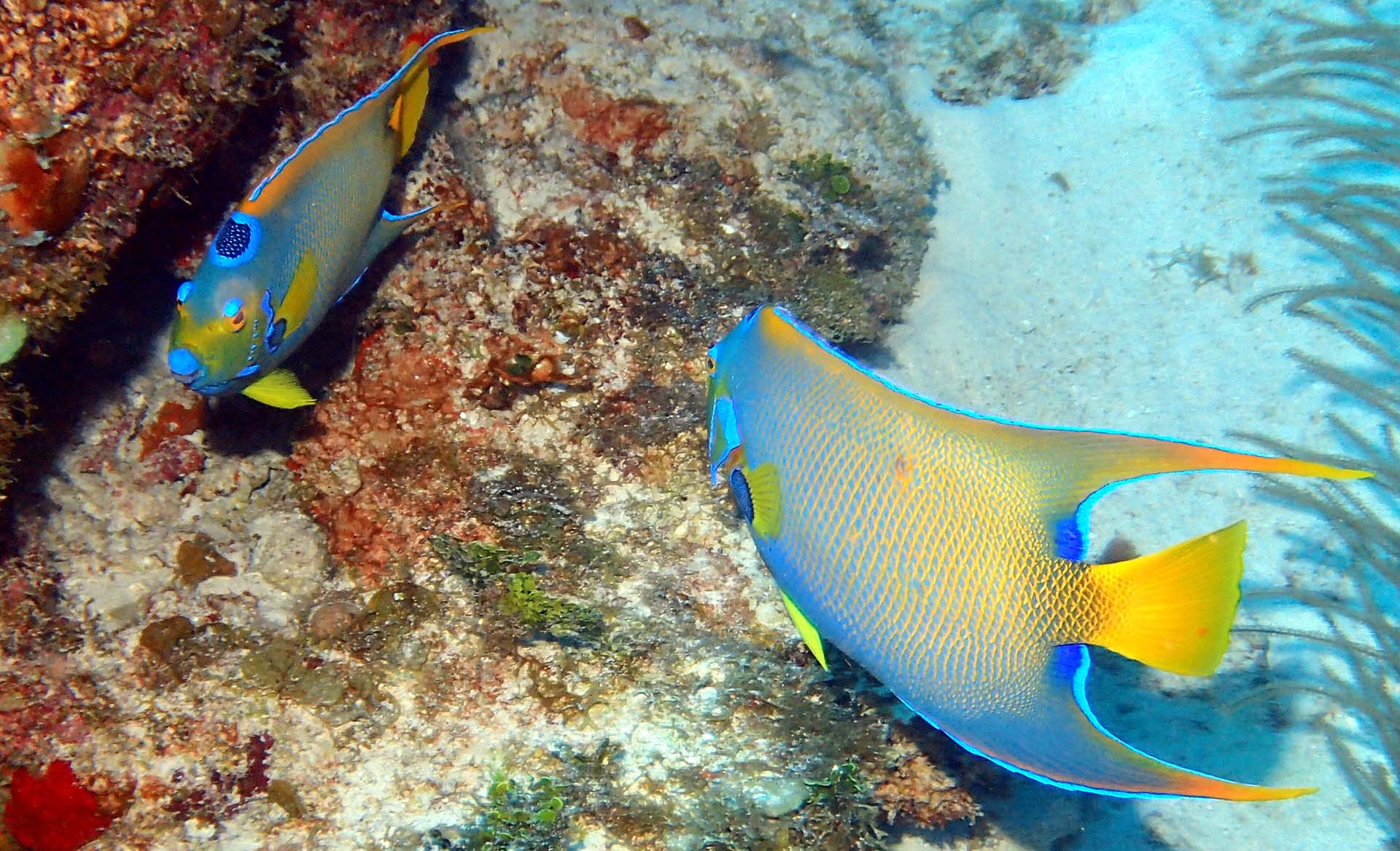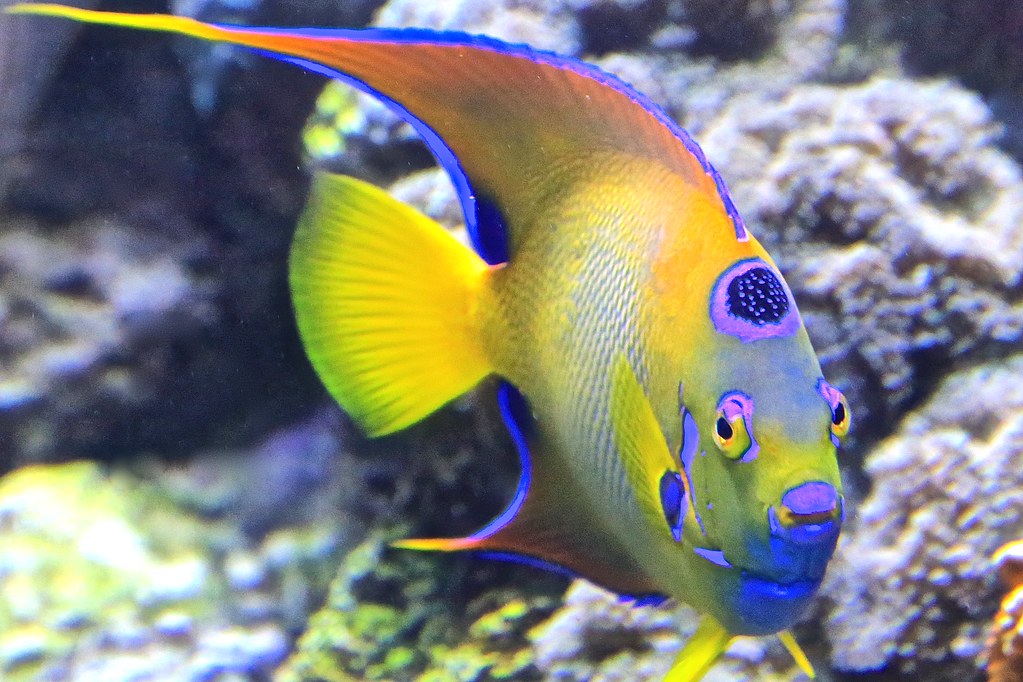Underwater realms hold mesmerizing creatures, among them the Queen Angelfish reigns supreme. With vibrant hues and graceful movements, these majestic creatures captivate aquarists and ocean enthusiasts alike.
Delving into their world not only reveals their stunning aesthetics but also unravels the secrets of queen angelfish lifespan, care, and habitat. Let’s explore the enchanting world of Queen Angelfish, understanding what queen angelfish eat (dietary needs), their captivating characteristics, and the art of nurturing them within home aquariums.
What are Angelfish
The angelfish, a true gem of the tropical waters, graces the ocean depths with its vibrant presence. Specifically, the Queen Angelfish (Holacanthus ciliaris) stands as royalty among its species, commanding attention with its stunning appearance and fascinating characteristics.

What distinguishes these angelfish is their glorious appearance. Adorned with shimmering sapphire and gold hues, and intricately patterned with vibrant accents, they resemble living artwork gliding through the depths. Their elongated bodies, trailing delicate fins, showcase elegance in motion, captivating the hearts of onlookers and fellow inhabitants of the reef.
Distribution and Habitat
Found in the warm, tropical waters of the Western Atlantic Ocean, from Florida down to Brazil and across the Caribbean Sea, their distribution spans a significant portion of this vibrant region. Inhabiting coral reefs and rocky crevices, Queen Angelfish thrives amidst the rich diversity of marine life, becoming an integral part of the intricate ecosystem.
Queen Angelfish exhibits fascinating behavior and social structures. They often form monogamous pairs, showcasing an inspiring loyalty to their chosen mates. These pairs gracefully navigate through their vibrant habitat, forging a connection that reflects the deep-seated bond within the angelfish species.
Queen Angelfish Lifespan
These majestic creatures boast an impressive lifespan, living up to 15 years in their natural habitat. Their lifecycle reveals an intriguing transformation from juveniles to adults. Juveniles display a markedly different appearance, donning a distinct coloration that gradually evolves as they mature into their full regal glory. This transition from juvenile to adult stages unveils the captivating metamorphosis these creatures undergo, adding to their allure.
What do Queen Angelfish Eat
Queen Angelfish, with their exquisite appearance, possess a diverse palate reminiscent of their royal status in the ocean. Their natural diet comprises an eclectic mix of marine delicacies, primarily consisting of sponges, algae, tunicates, and small invertebrates. In the wild, these regal creatures spend their days leisurely grazing on the vibrant offerings of coral reefs, relishing a buffet of textures and flavors that contribute to their health and vivid coloring.
Feeding Queen Angelfish in Captivity
What do queen angelfish eat in captivity? Replicating their natural diet within aquariums stands as a pivotal aspect of nurturing Queen Angelfish. Ensuring the health and vibrancy of Queen Angelfish hinges on a well-rounded diet packed with vital nutrients and vitamins. Imagine curating a menu that mirrors their oceanic buffet—a diverse blend of high-quality marine algae takes center stage. Think of Nori and Spirulina as the backbone of their culinary delights, serving as staple elements that keep them thriving.
Feeding Schedule
Feeding schedules for Queen Angelfish should be consistent, providing small portions multiple times a day. This approach aligns with their natural grazing behavior, ensuring they receive adequate nutrition while preventing overfeeding and subsequent water quality issues within the aquarium. Supplementing their diet with vitamin-enriched flakes or pellets designed for marine angelfish aids in fulfilling their dietary requirements.

Interesting Facts about Queen Angelfish
Beyond their breathtaking appearance, Queen Angelfish exhibit fascinating behaviors:
- They often form monogamous pairs, displaying remarkable loyalty to their chosen mates, navigating through coral reefs hand-in-fin.
- Additionally, juveniles display a distinct appearance, with different coloration than their adult counterparts, showcasing a mesmerizing transformation as they mature.
- They can digest the tough muscles and fat.
How to Keep Queen Angel Fish in Tanks
Creating a suitable environment in aquariums is pivotal for the thriving of Queen Angelfish. Here are some useful tips to keep your Queen Angelfish in tanks.
Creating the Ideal Habitat
Providing a suitable environment within a tank is vital for the well-being of Queen Angelfish. Start with a spacious tank, ideally no less than 180 gallons, allowing ample space for their graceful movements. Introduce live rocks that mimic their natural habitat, offering hiding spots and surfaces for grazing. Ensure a diverse range of structures to encourage exploration while also providing retreats when needed.
Water Quality and Conditions
Maintaining stable water parameters is paramount. Get yourself a top-notch filtration system—it’s the cornerstone of a pristine aquatic habitat for your Queen Angelfish. Think of it as their version of a sparkling clean palace. This system works tirelessly, keeping the water fresh and brimming with oxygen, just the way these majestic creatures prefer it.
Picture a 10-20% water swap every couple of weeks as their royal spa treatment. It’s like giving their environment a rejuvenating makeover, ensuring optimal water quality fit for royalty.
Temperature matters in this underwater realm — aim for that sweet spot between 72-78°F. It’s the temperature zone for these angelfish, and providing the ideal climate for them to thrive. So the heater for 180-gallon tanks is necessary here. Let’s not forget about pH levels; aim for that magic range of 8.1-8.4. It’s like finding the perfect balance for their underwater paradise.

Careful Selection of Tank Mates
Queen Angelfish can be territorial, so carefully choosing tank mates is crucial. Avoid housing them with aggressive or overly territorial species that might stress or harm them. Peaceful tank mates such as tangs, wrasses, or other angelfish species may cohabit peacefully, but close observation is necessary to prevent any conflicts. If you keep the zebrafish as the tank’s second inhabitant, keeping the balance of Zebrafish and Angelfish is challenging.
Feeding and Diet
Offer a varied diet that mimics their natural feeding habits. A combination of high-quality marine algae, spirulina, and frozen foods like shrimp or mussels ensures they receive essential nutrients. Feed small portions multiple times a day, as Queen Angelfish tend to graze continuously in the wild.
Observation and Maintenance
Regular observation is key to spotting signs of stress, illness, or aggression in the Queen Angelfish. Conduct routine checks on their behavior and physical appearance. Any sudden behavior change, loss of appetite, or appearance of lesions should prompt immediate attention and, if necessary, consultation with a knowledgeable aquarist or veterinarian in time.
Conclusion
The allure of Queen Angelfish extends beyond their stunning appearance. Understanding their habitat, dietary needs, and nuances of care enables aquarium enthusiasts to provide an environment where these regal beings flourish.
Their presence in home aquariums not only brings a slice of the ocean’s grandeur but also reminds us of the delicate balance required to nurture these magnificent creatures. As guardians of these aquatic treasures, let’s continue to explore, admire, and responsibly care for the Queen Angelfish, preserving their regal splendor for generations to come.
